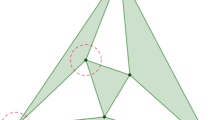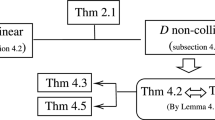Abstract
Let M be a 3 × 3 integer matrix which is expanding in the sense that each of its eigenvalues is greater than 1 in modulus and let \({\cal D} \subset {\mathbb{Z}^3}\) be a digit set containing |det M| elements. Then the unique nonempty compact set \(T = T(M,{\cal D})\) defined by the set equation \(MT = T + {\cal D}\) is called an integral self-affine tile if its interior is nonempty. If \({\cal D}\) is of the form \({\cal D} = \{ 0,v, \ldots ,(|\det M| - 1)v\} 0\), we say that T has a collinear digit set. The present paper is devoted to the topology of integral self-affine tiles with collinear digit sets. In particular, we prove that a large class of these tiles is homeomorphic to a closed 3-dimensional ball. Moreover, we show that in this case, T carries a natural CW complex structure that is defined in terms of the intersections of T with its neighbors in the lattice tiling {T + z: z ∈ ℤ3} induced by T. This CW complex structure is isomorphic to the CW complex defined by the truncated octahedron.
Similar content being viewed by others
References
An L-X, Lau K-S. Characterization of a class of planar self-affine tile digit sets. Trans Amer Math Soc, 2019, 371: 7627–7650
Bandt C. Self-similar sets. V. Integer matrices and fractal tilings of ℝn. Proc Amer Math Soc, 1991, 112: 549–562
Bandt C. Combinatorial topology of three-dimensional self-affine tiles. arXiv:1002.0710, 2010
Bandt C, Wang Y. Disk-like self-affine tiles in ℝ2. Discrete Comput Geom, 2001, 26: 591–601
Bing R H. A characterization of 3-space by partitionings. Trans Amer Math Soc, 1951, 70: 15–27
Conner G R, Thuswaldner J M. Self-affine manifolds. Adv Math, 2016, 289: 725–783
Conway J H, Burgiel H, Goodman-Strauss C. The Symmetries of Things. Wellesley: A K Peters, 2008
de Bruijn N G. A combinatorial problem. Indag Math (NS), 1946, 8: 461–467
Deng G T, Liu C T, Ngai S-M. Topological properties of a class of self-affine tiles in ℝ3. Trans Amer Math Soc, 2018, 370: 1321–1350
Diestel R. Graph Theory, 3rd ed. Graduate Texts in Mathematics, vol. 173. Berlin: Springer-Verlag, 2005
Fuglede B. Commuting self-adjoint partial differential operators and a group theoretic problem. J Funct Anal, 1974, 16: 101–121
Gentle J E. Matrix Algebra, 2nd ed. Theory, Computations and Applications in Statistics. Springer Texts in Statistics. Cham: Springer, 2017
Gröchenig K, Haas A. Self-similar lattice tilings. J Fourier Anal Appl, 1994, 1: 131–170
Harrold O G. Locally peripherally Euclidean spaces are locally Euclidean. Ann of Math (2), 1961, 74: 207–220
Harrold O G. A characterization of locally Euclidean spaces. Trans Amer Math Soc, 1965, 118: 1–16
Hata M. On the structure of self-similar sets. Japan J Appl Math, 1985, 2: 381–414
Hatcher A. Algebraic Topology. Cambridge: Cambridge University Press, 2002
Hutchinson J E. Fractals and self-similarity. Indiana Univ Math J, 1981, 30: 713–747
Kamae T, Luo J, Tan B. A gluing lemma for iterated function systems. Fractals, 2015, 23: 1550019
Kenyon R. Self-replicating tilings. In: Symbolic Dynamics and Its Applications. Contemporary Mathematics, vol. 135. Providence: Amer Math Soc, 1992, 239–263
Kirat I, Lau K-S. On the connectedness of self-affine tiles. J Lond Math Soc (2), 2000, 62: 291–304
Kwun K W. A characterization of the n-sphere. Trans Amer Math Soc, 1961, 101: 377–383
Lagarias J C, Wang Y. Self-affine tiles in ℝn. Adv Math, 1996, 121: 21–49
Lagarias J C, Wang Y. Integral self-affine tiles in ℝn. I. Standard and nonstandard digit sets. J Lond Math Soc (2), 1996, 54: 161–179
Lagarias J C, Wang Y. Integral self-affine tiles in ℝn. Part II. Lattice tilings. J Fourier Anal Appl, 1997, 3: 83–102
Lai C-K, Lau K-S. Some recent developments of self-affine tiles. In: Recent Developments in Fractals and Related Fields. Trends in Mathematics. Cham: Birkhäuser, 2017, 207–232
Lai C-K, Lau K-S, Rao H. Classification of tile digit sets as product-forms. Trans Amer Math Soc, 2017, 369: 623–644
Leung K-S, Lau K-S. Disklikeness of planar self-affine tiles. Trans Amer Math Soc, 2007, 359: 3337–3355
Luo J, Akiyama S, Thuswaldner J M. On the boundary connectedness of connected tiles. Math Proc Cambridge Philos Soc, 2004, 137: 397–410
Luo J, Thuswaldner J M. On the fundamental group of self-affine plane tiles. Ann Inst Fourier (Grenoble), 2006, 56: 2493–2524
Mauldin R D, Williams S C. Hausdorff dimension in graph directed constructions. Trans Amer Math Soc, 1988, 309: 811–829
Ngai S-M, Tang T-M. A technique in the topology of connected self-similar tiles. Fractals, 2004, 12: 389–403
Ngai S-M, Tang T-M. Topology of connected self-similar tiles in the plane with disconnected interiors. Topology Appl, 2005, 150: 139–155
Scheicher K, Thuswaldner J M. Neighbours of self-affine tiles in lattice tilings. In: Fractals in Graz 2001. Trends in Mathematics. Basel: Birkhäuser, 2003, 241–262
Tao T. Fuglede’s conjecture is false in 5 and higher dimensions. Math Res Lett, 2004, 11: 251–258
Thuswaldner J, Zhang S-Q. On self-affine tiles whose boundary is a sphere. Trans Amer Math Soc, 2020, 373: 491–527
Acknowledgements
The first author was supported by a grant funded by the Austrian Science Fund and the Russian Science Foundation (Grant No. I 5554). The second author was supported by National Natural Science Foundation of China (Grant No. 12101566). We thank the referees for their suggestions.
Author information
Authors and Affiliations
Corresponding author
Rights and permissions
About this article
Cite this article
Thuswaldner, J.M., Zhang, SQ. On self-affine tiles that are homeomorphic to a ball. Sci. China Math. 67, 45–76 (2024). https://doi.org/10.1007/s11425-022-2065-2
Received:
Accepted:
Published:
Issue Date:
DOI: https://doi.org/10.1007/s11425-022-2065-2




